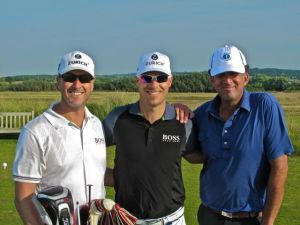HOYLAKE, ENGLAND — Ben Crane is a five-time winner on the PGA Tour. He’s also a keen judge of golf courses, which is why I fumbled to get my log book open when Ben started gushing about 38th-ranked Wallasey Golf Club. “Does it get any better than this?” he asked on the fourth tee, which rides a dune high above a fairway that follows the shoreline south along the Irish Sea.
“This is as good as it gets, isn’t it?” He spread his arms like Moses. “I mean, are you telling me there’s something better than this?”
This was yesterday evening, at the end of a long, sunny day that saw the recent FedEx St. Jude Classic winner fail by a whisker to get into the Open Championship as a first alternate. Many of his peers were still on the course at 51st-ranked Royal Liverpool, a few miles down the coast. “I’d love to have gotten in,” he said, “but I wasn’t going home without playing some links golf.”
For a complete and more nuanced account of gallant Ben’s visit, I give you this by my playing partner and SI colleague, Michael Bamberger. Read it at your leisure, and then come back for my obligatory take on the Wallasey links.

A walk on the wild side at Wallasey links with (l to r) caddie Joel Stock, PGA Tour pro Ben Crane and SI senior writer Michael Bamberger. (John Garrity)
Ah, good to have you back. I’ll start by answering Ben’s question: Yes, it does get better than Wallasey. After all, there are 37 higher-ranked courses in the Top 50. But that’s the data talking, and I, like Ben, am suspicious of data, even when it’s cranked out by an instrument as dependable as the Bomar Brain. To be honest, I’ve been uneasy about Wallasey’s high ranking ever since it debuted at No. 48 a few years ago. I pestered my staff with questions: “What can you tell me about the place? Why did you waive the deduction for no drinking fountains? How long should a tick bite remain inflamed before I call a doctor?”
Beyond the raw numbers, all they could tell me was that Wallasey was the home club of Dr. Frank Stableford, the man who invented the Stableford Rules for golf scoring. Well, hoop dee doo. I’ve invented more than a dozen scoring protocols, none of which require me to record every stroke I take on a hole.
That said, I found Wallasey to be enchanting. With its big shaggy dunes and glorious sea views, it’s a close cousin to top-ranked Askernish and Carne, my two favorite courses. Furthermore, it is quirky. One fairway crosses directly in front of another tee. There’s a 90-degree dogleg-right par-4 that skirts a grove of trees — trees on a links? — and climbs a steep hill to a blind green. There’s a long par-4 that requires a blind approach shot of around 200 yards into a natural amphitheater that was probably popular with the Druids. Quirky links, to my way of thinking, are the best kind.
Don’t ask me to choose between homely Royal Liverpool and fetching Wallasey, because I’ll take Wallasey every time. And so will Bamberger, who’s right back out there this afternoon with his pal Mike Donald, runner-up to Hale Irwin at the 1990 U.S. Open. “The course is an absolute delight,” Michael B. writes in his Crane piece. He singles out the fifth — “a par 3 that played about 160 yards into the wind off the Irish sea, from an elevated tee” — as “a gem.”
We’ll have to wait for Mike Donald’s take. But if he gives it a thumbs up, Wallasey could ascend a rung or two before I reach Ireland.
Top 50 on TV: Nothing this week, but the Open Championship continues at 51st-ranked Royal Liverpool Golf Club, a curious, small-dunes links with knee-high mole-cricket runs delineating arbitrary out-of-bounds boundaries. It’s no Wallasey, but it possesses an undeniable 19th-century charm. We have advised the R&A that it be kept in the Open rota — only, perhaps, on a less-frequent basis.*
*We provided our recommendation on a pro bono basis and have not yet heard back from the R&A.













